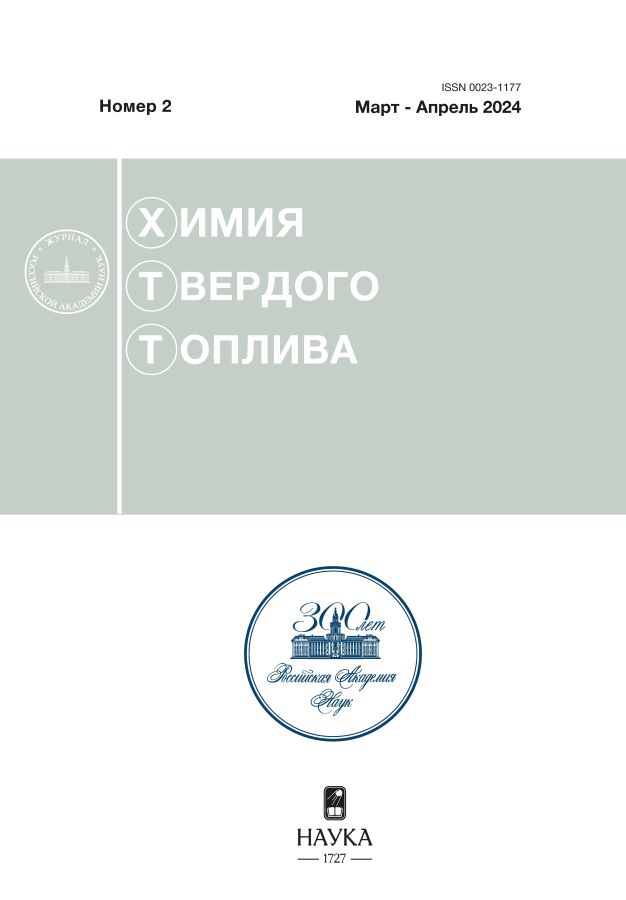Transformations of Asphaltenes A1 and A2 During Atmospheric Residue Cracking
- Autores: Sviridenko N.N.1, Sergeyev N.S.1, Urazov K.K.1
-
Afiliações:
- Institute of Petroleum Chemistry, Siberian Branch of the Russian Academy of Sciences
- Edição: Nº 2 (2024)
- Páginas: 37-43
- Seção: Articles
- URL: https://journals.eco-vector.com/0023-1177/article/view/661581
- DOI: https://doi.org/10.31857/S0023117724020079
- EDN: https://elibrary.ru/OMJJET
- ID: 661581
Citar
Texto integral
Resumo
In this work, various conditions for cracking the atmospheric residue of the Novokuibyshevsk oil refinery are considered and analyzed. The optimal conditions for cracking the atmospheric residue have been established as a temperature of 450°С and a duration of 30 minutes. These conditions result in an additional 51.8 wt % of light fractions due to the destruction of 31.3 wt % of resin-asphaltene components. The study also examines the compaction products formed during cracking. The study analyzed two fractions of asphaltenes (A1 and A2) isolated from liquid cracking products using the method of structural group analysis. It was found that the duration of atmospheric cracking had an impact on the formation of secondary asphaltenes.
Palavras-chave
Texto integral
Sobre autores
N. Sviridenko
Institute of Petroleum Chemistry, Siberian Branch of the Russian Academy of Sciences
Autor responsável pela correspondência
Email: nikita26sviridenko@gmail.com
Rússia, Tomsk
N. Sergeyev
Institute of Petroleum Chemistry, Siberian Branch of the Russian Academy of Sciences
Email: nikitaser99@gmail.com
Rússia, Tomsk
Kh. Urazov
Institute of Petroleum Chemistry, Siberian Branch of the Russian Academy of Sciences
Email: urazovhh@gmail.com
Rússia, Tomsk
Bibliografia
- Matuszewska A., Owczuk M., Biernat K. // Energies. 2022. V. 15. P. 2719. https://doi.org/10.3390/ en15082719
- Sviridenko N.N., Urazov Kh.Kh. // Pet. Sci. Technol. 2023. 41. 20. P. 1918-1933. https://doi.org/10.1080/10916466.2022.2104872
- Гончаров А.В., Кривцов Е.Б., Юрлов С.С. // ХТТ. 2022. 2. С. 56. https://doi.org/10.31857/S0023117722020025 [Goncharov, A. V. Krivtsov E. B., Yurlov S. S. // Solid Fuel Chemistry. 2022, vol. 56, no. 2, p. 138–144. https://doi.org/10.3103/S0361521922020021].
- Иовик Ю.А., Кривцов Е.Б. // Химия в интересах устойчивого развития. 2020. 4. C. 439. https://doi.org/10.15372/KhUR2020249 [Iovik Y.A., Krivtsov E.B. // Chemistry for Sustainable Development. 2020. 4. p. 425. https://doi.org/10.15372/CSD2020249].
- Бояр С.В., Копытов М.А. // ХТТ. 2023. 2 – 3. С. 92. https://doi.org/10.31857/S0023117723020020 [Boyar, S.V., Kopytov, M.A. Solid Fuel Chem. 2023, vol. 57, p. 82. https://doi.org/10.3103/S0361521923020027].
- Yakubov M.R., Abilova G.R., Yakubova S.G., Mironov N.A. // Pet. Chem. 2020. V. 60. P. 637. https://doi.org/10.1134/S0965544120060109
- Yoshikazu S., Yukichi H., Yoshiaki S., Tugsuu T., Enkhsaruul B. // J. Jpn. Petrol. Inst. 2013. V. 56. 1. P. 44. https://doi.org/10.1627/jpi.56.44
- Akimov A.S., Sviridenko N.N. // Pet. Sci. Technol. 2022. V. 40. 8. P. 980. https://doi.org/10.1080/10916466.2021.2008973
- Manasrah A.D., Nassar N.N. // Applied Energy. 2020. V. 28. P. 115890. https://doi.org/10.1016/j.apenergy.2020.115890
- Oh K.S. // J. Korean Chem. Soc. 2014. 31. P. 151. https://doi.org/10.12925/jkocs.2014.31.1.151
- Нальгиева Х.В., Копытов М.А. // ХТТ. 2022. № 2. С. 34. https://doi.org/10.31857/S0023117722020074 [Nal’gieva Kh. V., Kopytov M.A. // Solid Fuel Chemistry, 2022, vol. 56, no. 2, p. 116. https://doi.org/10.3103/S0361521922020070
Arquivos suplementares













